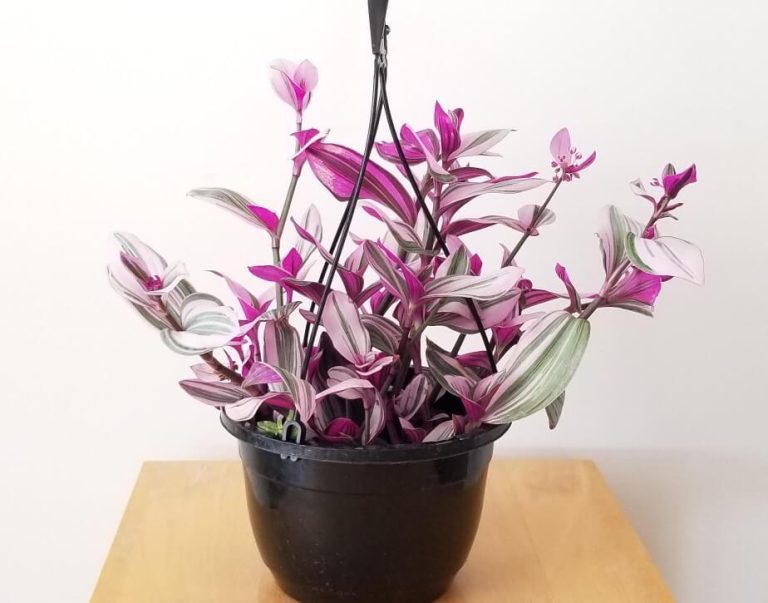Exploring The Diversity Of Tradescantia Varieties: A Comprehensive Guide To Identifying And Caring For Different Types Of Tradescantia Plants
Choosing the right houseplant can be a challenge when you’re faced with so many beautiful options. Among them, Tradescantia – known for its diverse varieties and ease of care – has become a popular choice among gardeners worldwide.
This blog post will walk you through everything you need to know about this remarkable plant species, from understanding their unique characteristics to comprehensive care guides for each variety.
Ready to explore the world of Tradescantia?.
Key Takeaways Tradescantia Varieties
- Tradescantia plants, also known as Wandering Jew plants, are a diverse group of houseplants that offer vibrant and versatile foliage.
- There are numerous varieties of Tradescantia plants, including Tradescantia Zebrina, Tradescantia fluminensis, Tradescantia mundula Laekenensis Rainbow or Tricolor, and many more. Each variety has its own unique characteristics and care requirements.
- Most Tradescantia varieties are low – maintenance and suitable for beginners. They can thrive in both water or soil environments and can be easily propagated through stem cuttings.
- Proper care for Tradescantia plants includes providing them with the right amount of light (bright indirect light is best), watering when the top inch of soil feels dry, and regular pruning to maintain their shape and promote new growth.
Characteristics of the Wandering Jew (Tradescantia)
Stepping into the verdant world of Tradescantia, also known as Wandering Jew plants, you’ll be greeted by an array of vibrant and versatile foliage. These popular houseplants boast distinctive zebra-like patterns across their leaves, a characteristic that’s particularly pronounced in varieties like the widely adored Tradescantia Zebrina.
Despite such striking appearances, these trailing beauties are surprisingly low-maintenance – often hailed as beginner-friendly assets to any indoor garden.
While some may refer to them as spiderwort or inch plants, they all fall within the same captivating genus: Tradescantia. Most varieties embrace a vine-like growth habit that can adapt readily to diverse environments – thriving in water or soil with equal enthusiasm.
As another testament to their versatility and vigor, propagation via cuttings is simple and straightforward with these resilient cultivars. As you delve into exploring individual types of tradescantia plant varieties further, keep this robust determination in mind – it’s part of what makes each variety a long-living addition ready to bring unique charm and color to your gardening space!
How to Identify and Care for Tradescantia Varieties
To identify and care for different varieties of Tradescantia plants, you need to familiarize yourself with their specific characteristics and requirements.
Tradescantia Zebrina
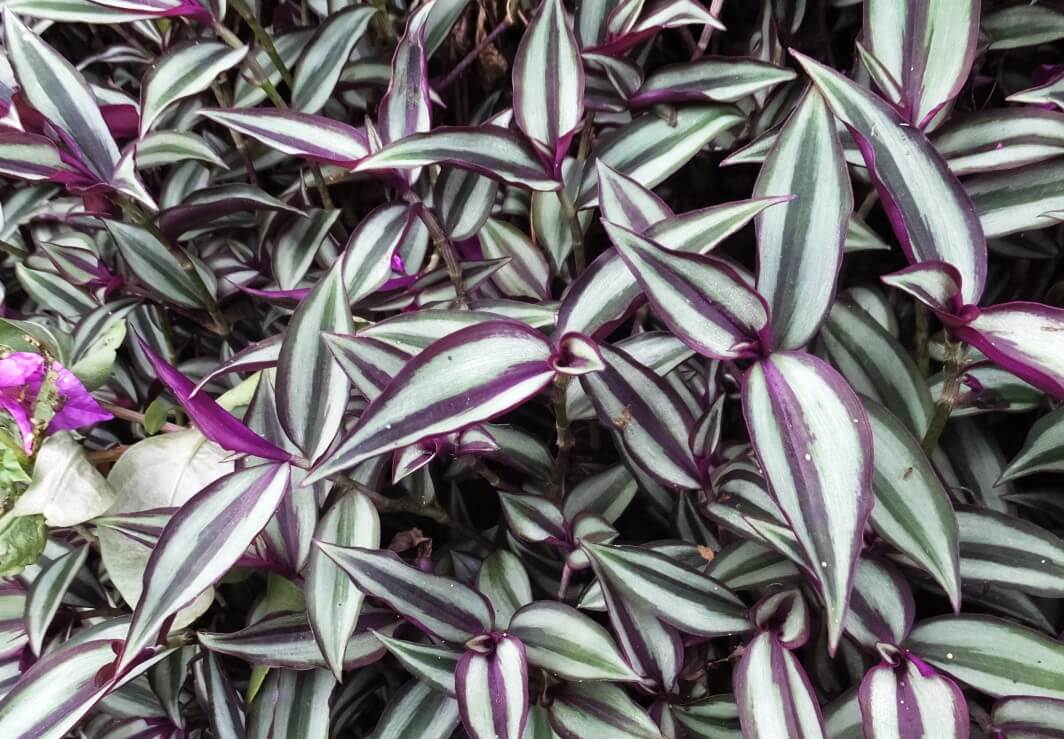
Delightfully decorative and easy to care for, Tradescantia Zebrina is a garden favorite. This variety, often hailed as the Inch Plant or Wandering Jew, has its roots in the warm climates of southern Mexico and Guatemala.
Rendered distinct by its variegated foliage, each leaf displays a captivating blend of green, white, and gray stripes with purple undersides.
Tradescantia Zebrina’s aesthetic appeal doesn’t end at its vibrant colors; it also boasts a versatile growth style that shines in various settings. Houseplant enthusiasts can be seen utilizing this stylish cultivar indoors due to its low-maintenance nature suitable for beginners and busy plant parents alike.
On brighter days you might find it basking under indirect light or partial shade as it tolerates both conditions well without compromising on growth performance.
Watering needs are equally fuss-free; simply touch the top inch of soil to see if it feels dry before watering again. Both indoor decor and outdoor landscapes benefit from its presence – hang it in your living room basket or let it sprawl freely as refreshing ground cover in your backyard oasis.
One remarkable feature of Tradescantia Zebrina is how easily you can multiply them through stem cuttings which further enhances their appeal amongst propagated plant lovers! Regular pruning helps retain shape while promoting new growths making sure your greenspace remains visually stunning year-round.
Tradescantia fluminensis
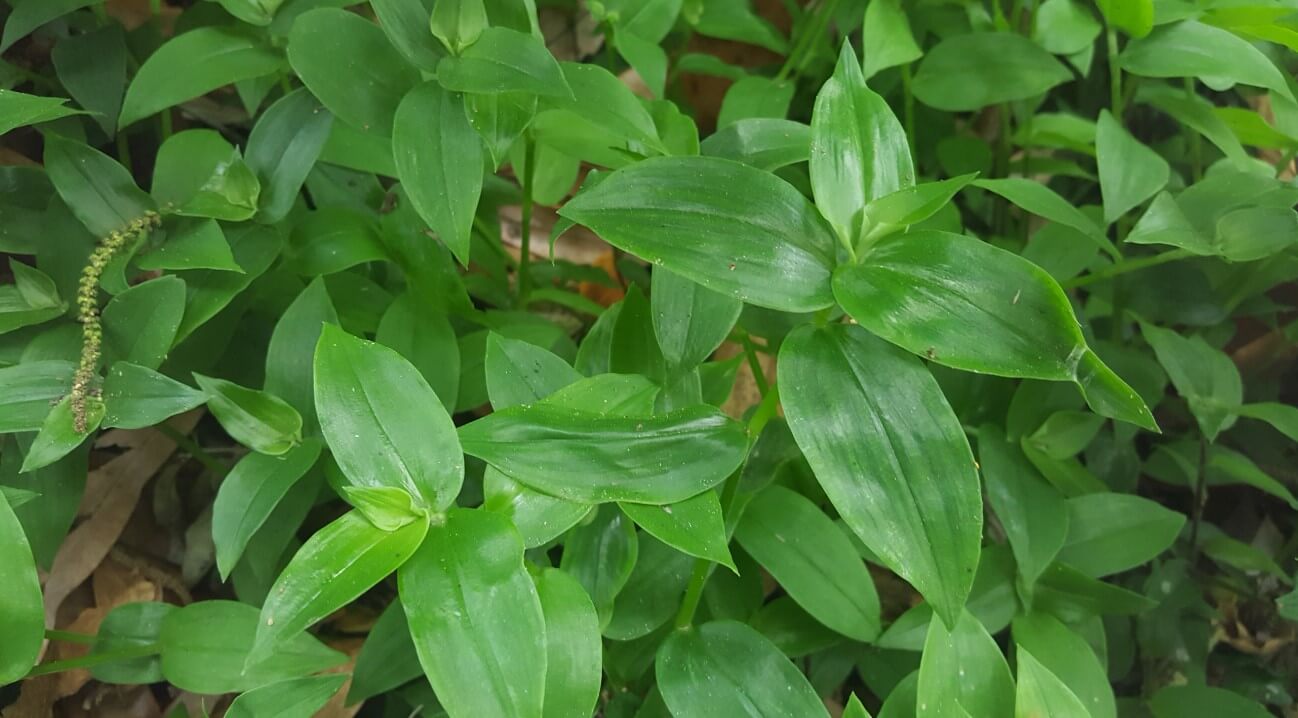
Dive into the world of Tradescantia and you’ll discover a variety known as Tradescantia fluminensis. Affectionately dubbed Wandering Jew or Inch Plant, this trailblazing species is perfect for hanging baskets or adorning shelves with its cascading branches covered in oval-shaped leaves.
The classic green color of the foliage can vary, presenting intriguing variegated varieties that exude a touch of cream or white mingling with the iconic green. Easy to care for, Tradescantia fluminensis holds a cherished spot among beginner gardeners and experienced plant enthusiasts alike.
Tolerating some shade while thriving in bright, indirect light, it requires watering only when the top inch of soil has dried out. With its fast-growing nature, regular pruning might be necessary if you prefer to keep it compact.
However, let it grow wild and free if your aesthetic leans towards lush indoor jungles! Bonus point: stem cuttings easily propagate this plant, so sharing this beauty within your circle becomes an effortless joy!
Tradescantia mundula Laekenensis Rainbow or Tricolor
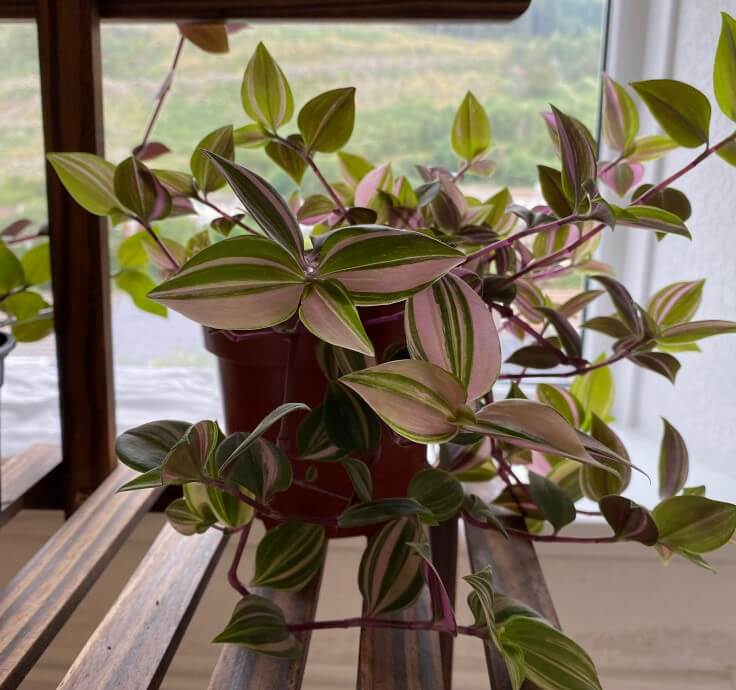
Tradescantia mundula Laekenensis Rainbow or Tricolor is a stunning variety of the popular Tradescantia plant. Native to South America, this fast-growing beauty boasts vibrant and variegated foliage that instantly adds a burst of color to any space.
Its leaves feature strong pink and white variegation, creating a captivating display that will catch anyone’s eye. This variety is particularly well-suited for hanging baskets due to its trailing growth habit.
Whether you’re an experienced gardener or just starting out, this easy-to-care-for Tradescantia variety is sure to bring joy and vibrancy to your indoor or outdoor garden.
Tradescantia Sillamontana Matuda (White Velvet)
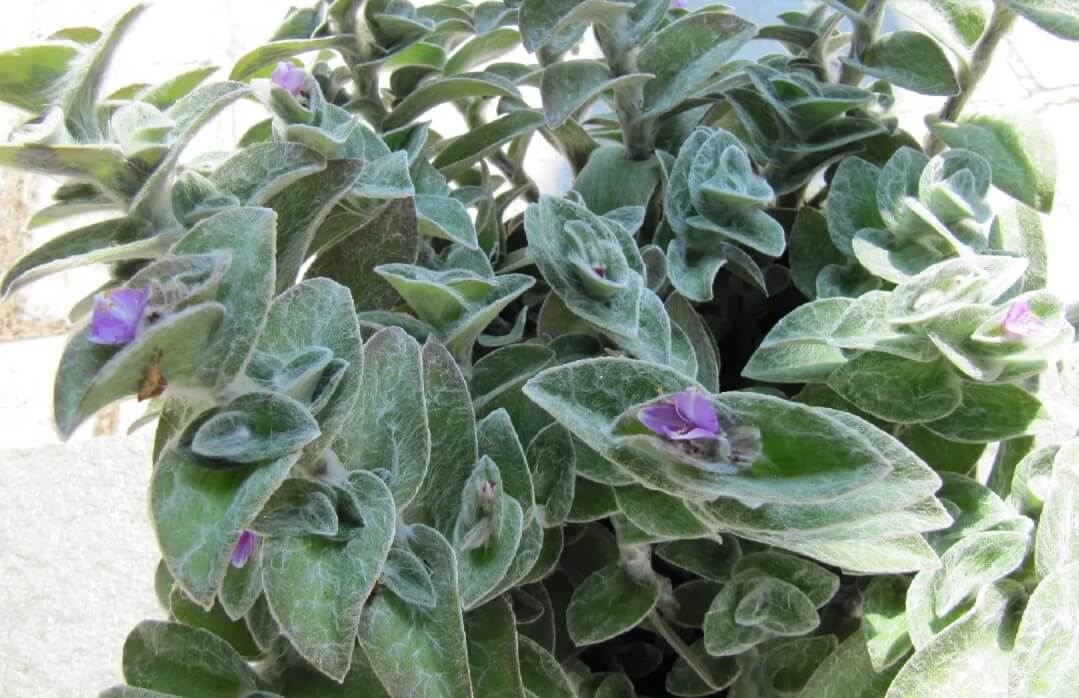
The Tradescantia Sillamontana Matuda, also known as White Velvet, is a stunning variety of the wandering jew plant. It features oval-shaped leaves that are densely covered in a gray-green color, giving it a unique and charming appearance.
This evergreen perennial plant requires consistent moisture year-round, making it important to keep its soil consistently moist. With its fleshy stems and succulent leaves, this low-maintenance plant can easily be cared for both indoors and outdoors.
Propagating the White Velvet variety can be done through stem cuttings or division of the plant. However, it’s essential to note that Tradescantia Sillamontana may be toxic to pets if ingested.
Tradescantia blossfeldiana (cerinthoides) variegata (smooth form) – ‘Lilac’
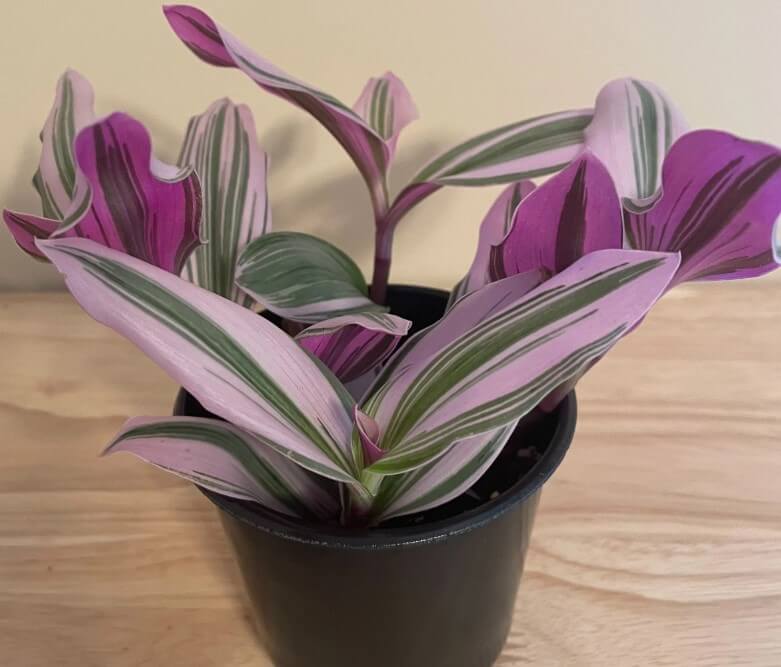
One stunning variety of Tradescantia plants that you should definitely consider adding to your collection is the ‘Lilac’ (Tradescantia blossfeldiana cerinthoides variegata). With its fast-growing nature and fleshy leaves in shades of lilac, green, pink, and cream, this succulent plant will surely add a pop of color to any room.
The ‘Lilac’ variety is known for its smooth leaves, giving it a unique texture compared to other Tradescantia varieties. As part of the larger Tradescantia genus, which includes over 75 different perennial plants, ‘Lilac’ is a fantastic choice if you want an easy-to-care-for houseplant.
It thrives in bright indirect light and well-draining soil while appreciating regular watering with slight drying between waterings. Propagating ‘Lilac’, as well as other Tradescantia varieties like nanouk, fluminensis variegata, and zebrina can be done easily through stem cuttings – making them perfect options for beginners.
Tradescantia pallida ‘Pale Puma’
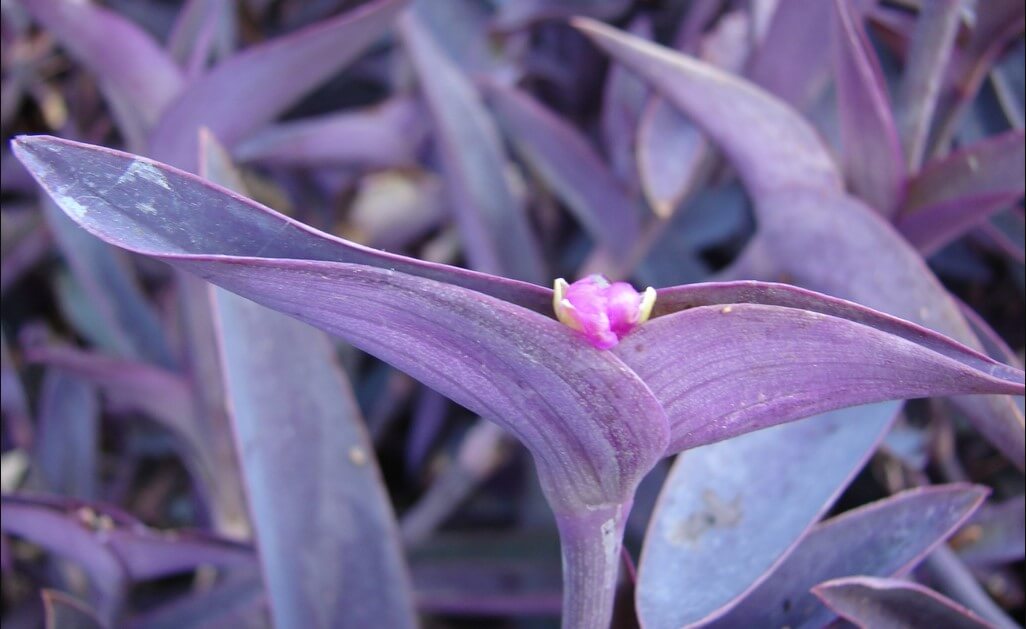
Tradescantia pallida ‘Pale Puma’ is a stunning variety of Tradescantia that will add a pop of color to your garden or indoor space. This hybrid plant, a cross between T. pallida and T.
sillamontana, features oval-shaped leaves that start off pale green in the center and gradually fade to a beautiful shade of purple around the edges. Growing up to 1 foot tall and 3 feet wide, this ground cover plant forms dense clusters of fleshy stems covered in soft purple leaves that are adorned with silver hairs.
In the spring and summer, ‘Pale Puma’ blooms delicate pink flowers with yellow stamens, adding even more visual interest to its already striking foliage. To keep this easy-to-grow variety thriving, make sure it receives regular watering, indirect sunlight, and well-draining soil.
Tradescantia pallida ‘Purple Heart’
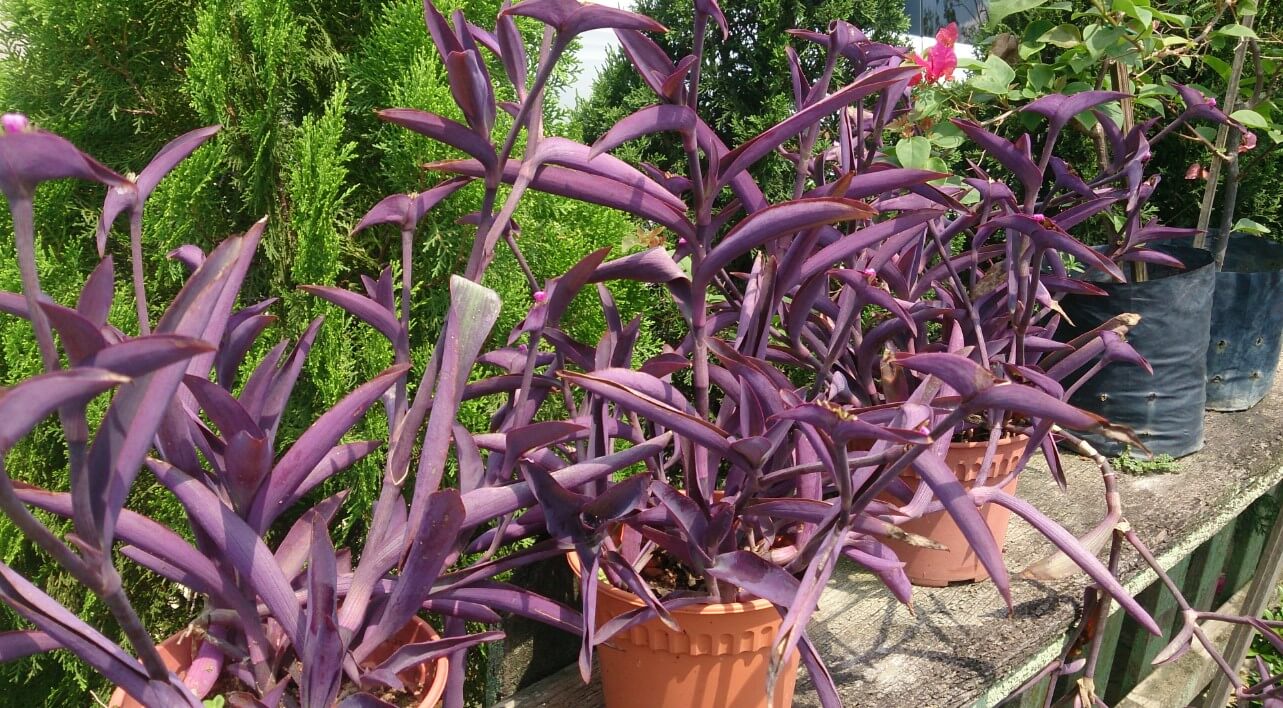
Tradescantia pallida ‘Purple Heart’ is a gorgeous and easy-to-care-for plant that will add a pop of color to your indoor or outdoor space. This tender evergreen perennial, native to northeast Mexico, features striking purple stems and violet-purple foliage that cascades beautifully.
It’s commonly grown as an ornamental plant for its unique appearance. Whether you choose to keep it as a houseplant or incorporate it into your garden, taking care of Tradescantia pallida ‘Purple Heart’ is a breeze.
This low-maintenance plant thrives in bright light conditions and prefers well-draining soil. With its stunning purple leaves and occasional pink flowers, this variety is sure to be a showstopper in any setting.
Tradescantia ohiensis (Ohio Spiderwort)

Ohio Spiderwort, scientifically known as Tradescantia ohiensis, is a stunning perennial plant that will add a touch of beauty to any garden. This clump-forming herbaceous plant features long, arching leaves with a beautiful blue-green color and unique folded shape.
Reaching heights of 2-3 feet, its erect stems bear clusters of vibrant three-petaled blue flowers with a diameter of 0.75-1.5 inches. Native to North America and found in various parts of the United States, Ohio Spiderwort is not only visually appealing but also easy to care for.
It thrives in well-draining soil and prefers to be watered when the top one to two inches have dried out between waterings. This low-maintenance plant is perfect for perennial beds and native or pollinator gardens where it can be appreciated for its attractive foliage and ornamental value.
Tradescantia Spathacea (Rhoeo Oyster)

Tradescantia Spathacea, also known as Rhoeo Oyster, is a striking variety of Tradescantia plant that is sure to catch your eye. With its boat-shaped bracts and small white flowers, this plant adds a unique touch to any garden or indoor space.
Its tropical foliage and vibrant colors make it an excellent choice for those looking to add some visual interest to their collection.
Care for the Tradescantia Spathacea is relatively low-maintenance, making it perfect for both beginner and experienced gardeners. This variety thrives in bright indirect sunlight, so be sure to place it in a location where it can receive plenty of light without being directly exposed.
When it comes to watering, allow the soil to dry out slightly between waterings, but be careful not to overwater as this can lead to root rot.
Tradescantia Nanouk
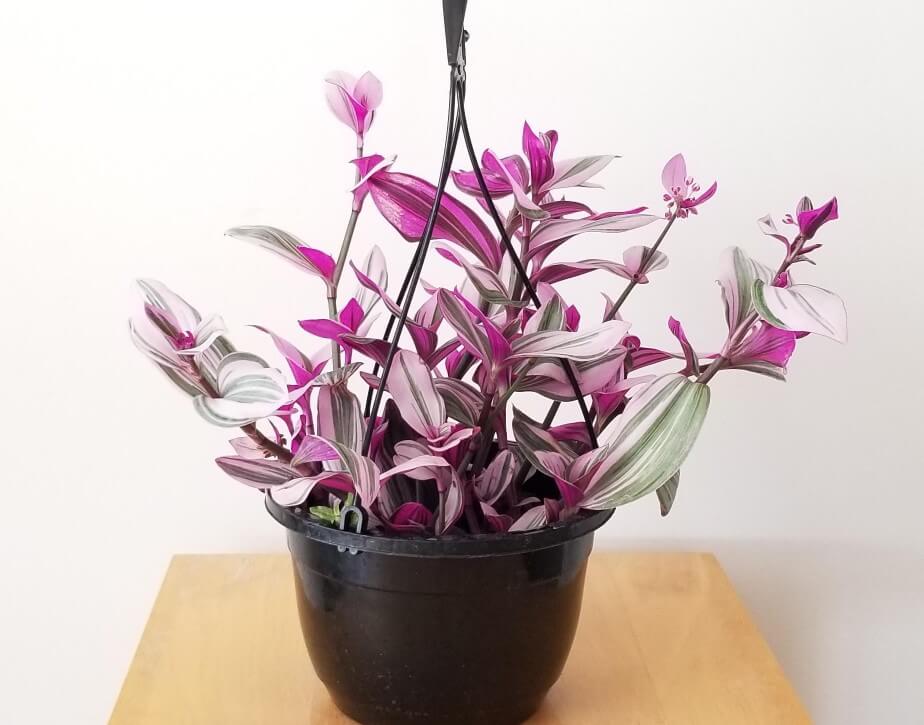
Tradescantia Nanouk is a popular houseplant that has quickly gained popularity among gardeners. This stunning plant features leaves with beautiful pink streaks, making it a gorgeous addition to any indoor space.
It is actually a cultivar of Tradescantia albiflora and requires bright, indirect light in order to thrive. When it comes to watering, it’s important to let the top inch of soil dry out before watering again, but be careful not to overwater as this can lead to root rot.
In terms of care, maintaining humidity levels will benefit the growth of this plant. Tradescantia Nanouk can be easily propagated through stem cuttings if you want more plants for your collection.
Be sure to position this plant in an area with adequate light to prevent leggy growth and brown leaves caused by insufficient lighting. One great thing about Tradescantia Nanouk is that it is non-toxic to pets, allowing you peace of mind if you have furry friends at home.
Caring for Tradescantia Plants
To care for Tradescantia plants, ensure they receive bright but indirect light, maintain a consistent temperature between 60-85°F (15-29°C), water when the top inch of soil is dry, provide moderate humidity levels, fertilize with a balanced liquid fertilizer every 2-4 weeks during the growing season, prune regularly to promote bushier growth and remove any dead or yellowing leaves.
Light requirements
Tradescantia plants thrive in bright, indirect light, so finding the right spot in your home is crucial for their growth. Aim for six to eight hours of morning sun with filtered or indirect light throughout the day to keep them happy and healthy.
Insufficient light can cause fading of the plant’s leaves and affect their beautiful leaf markings. While tradescantia can tolerate different light levels indoors, they may become washed-out looking if kept in too much shade.
Remember that too little sun can also result in leggy growth, so find a balance and provide enough light for these stunning plants to maintain their variegated appearance.
Temperature preferences
Tradescantia plants have specific temperature preferences that you need to keep in mind when choosing the right variety for your garden. These plants thrive in average room temperatures between 60-80°F, making them perfect for indoor cultivation.
However, it’s important to note that Tradescantia species are sensitive to temperature fluctuations and should be kept away from drafts or extreme temperature changes. They prefer warm but not hot conditions, so maintaining a stable environment is crucial for their well-being.
With some attention to temperature control, you can create the ideal conditions for these stunning plants to flourish and bring beauty into your home or garden space.
Watering needs
To keep your Tradescantia plants healthy and thriving, it’s important to meet their watering needs. These plants require regular moisture, so be sure not to let them dry out completely.
A consistent watering schedule is key, especially during the winter months when indoor environments tend to be drier. Spiderworts, a popular type of Tradescantia, should be watered when the top inch or two of soil has dried out.
It’s also essential to use well-draining soil that is fertile and fresh when transplanting your Tradescantia varieties. Remember, overwatering can lead to root rot, so monitor the moisture levels of the soil carefully.
Humidity preferences
Tradescantia plants, including the different varieties, are native to humid, tropical environments. Therefore, they thrive in high humidity conditions. Insufficient humidity can result in tip browning of the leaves, especially in dry air.
To keep your Tradescantia varieties happy and healthy, it’s important to provide them with a humid environment. Consider placing a tray filled with water near your plants or using a humidifier to increase moisture levels.
Misting the foliage regularly can also help mimic their natural habitat and prevent leaf dryness. Remember that maintaining proper humidity is essential for vibrant growth and overall well-being of your Tradescantia collection.
Fertilizing guidelines
To keep your Tradescantia plants thriving, it’s important to provide them with the right nutrients. Fertilizing these varieties is essential for their healthy growth and vibrant foliage.
One recommended method is to use liquid fertilizer at half strength once a month or opt for a controlled-release fertilizer during planting time. This will ensure that your Tradescantia plants receive a steady supply of nutrients over time.
Remember, proper fertilization can have a significant impact on the overall health and appearance of your plants, so don’t skip this important step in caring for your Tradescantia varieties.
Pruning tips
Keeping your Tradescantia plants in optimal shape and appearance requires regular pruning. Pruning is an essential part of caring for these varieties, as it helps control their growth and prevents them from becoming leggy.
By pinching back weak or sparse tendrils and tips, you can maintain a bushy look and promote healthy growth. It’s important to avoid cutting too far back when pruning to prevent damage to the plant.
Additionally, if you have a specific variety like Tradescantia Bubblegum, removing overcrowded or weak stems will encourage fuller growth. Regular pruning is key to shaping and maintaining the overall appearance of your stunning Tradescantia plants without being overwhelming or invasive.
Propagation methods
Tradescantia plants are easy to propagate, allowing you to expand your collection and share with friends. Here are the different methods you can use to propagate Tradescantia varieties:
- Stem cuttings: Take a 4-6 inch stem cutting from a healthy Tradescantia plant just below a node. Remove the lower leaves and place the cutting in water or directly into moist potting soil. Roots will develop in about 2-3 weeks.
- Division: Divide clump-forming varieties, such as Tradescantia fluminensis, by carefully separating the plant into smaller sections. Each section should have roots and several stems. Plant each division in its own pot or location in the garden.
- Offsets: Some Tradescantia plants produce offsets, small plantlets that grow from the base of the parent plant. Gently separate these offsets from the main plant and pot them up individually.
- Seed: Collect ripe Tradescantia seeds and sow them in seed-starting mix. Cover lightly with soil and keep moist. Seeds will germinate in 2-4 weeks.
Best Uses for Tradescantia Varieties
Tradescantia varieties are incredibly versatile and can be used in a variety of ways. They make stunning indoor decorations, especially when placed in hanging baskets or used as ground cover.
Tradescantia plants also thrive in container gardens, adding vibrancy to any space. Discover the best uses for these beautiful plants and how they can enhance your home or garden.
Indoor decoration
Tradescantia plants are an excellent choice for indoor decoration, adding a touch of natural beauty to your home or office space. With their colorful and trailing foliage, Tradescantia varieties like Tradescantia fulminensis, Tradescantia zebrina, and Tradescantia albiflora can create stunning hanging displays or be used as ground cover in larger pots.
These plants thrive in both tropical and hardy indoor environments, making them versatile options for any gardener. Whether you’re looking for vibrant greens, variegated leaves, or pops of color with flowers like the popular Tradescantia nanouk or the variegated fluminensis variety, there’s a perfect Tradescantia plant to suit your aesthetic preferences.
Plus, with their easy-care nature and low-maintenance requirements, these delightful plants are sure to brighten up any interior space effortlessly.
Hanging baskets
Tradescantia plants are perfect for hanging baskets, adding a touch of elegance and greenery to any space. These versatile plants have trailing foliage that cascades beautifully over the sides of the basket, creating a stunning display.
Tradescantia varieties, such as the popular nanouk and burgundy, are particularly well-suited for this purpose. The deep purple leaves of these plants make them visually striking and eye-catching.
Plus, Tradescantias are low-maintenance and non-toxic, making them safe to have in households with pets or children. So whether you want to create an indoor oasis or spruce up your patio decor, consider planting Tradescantias in hanging baskets for a vibrant and charming addition to your garden.
Ground cover
Tradescantia plants are not only beautiful additions to your garden but they can also be used as versatile ground cover. The fast-growing and easy-to-care-for nature of Tradescantia makes it ideal for filling in bare spots or covering large areas of your yard.
With their sprawling stems and lush foliage, varieties like Tradescantia Zebrina ‘Purpusii’ make stunning low-growing mats that add color and texture to any landscape. Whether you have a warm or temperate climate, these spiderworts can thrive as ground covers, creating a vibrant carpet-like effect.
Plus, the wide range of colors available, from the variegated foliage of Tradescantia fluminensis variegata to the eye-catching shades in Tradescantia nanouk and Tradescantia tricolor, allow you to customize your ground cover look according to your preference.
Container gardening
Container gardening is a popular and convenient way to grow Tradescantia varieties, especially for gardeners looking to choose from the diverse range of options available. Whether you have limited space or simply prefer the flexibility that containers offer, Tradescantia plants are well-suited for this method.
They can be grown both indoors and outdoors in pots, allowing for easy maintenance and control over their growth. With their vibrant foliage colors and patterns, these beautiful plants will add an eye-catching element to any container garden.
Plus, container gardening with Tradescantia varieties offers versatility in terms of placement and design. You can use them as trailing plants in hanging baskets or as focal point plants in larger containers.
Another advantage of growing Tradescantia in containers is their ease of propagation – they readily root from cuttings, making it simple to expand your collection or share with fellow plant enthusiasts.
Common Pests and Diseases
Tradescantia plants can be susceptible to common pests such as aphids and spider mites, which can cause damage to the foliage. Root rot is another common issue that may arise if the plants are overwatered or if they do not have proper drainage.
Keep an eye out for these pests and diseases and take appropriate measures to prevent or treat them to ensure the health of your Tradescantia plants.
Aphids
Aphids can be a common nuisance for Tradescantia plants, but with the right strategies, you can keep these pesky insects under control. Aphids are tiny pear-shaped insects that suck sap from plants, which can weaken and damage them.
They come in various colors and may feed on different species of closely related plants. In fact, aphids are responsible for causing between 25% to 50% of all viral plant diseases.
You can recognize an aphid infestation by spotting small insects on your Tradescantia plants.
One important thing to note is that aphids excrete a sticky substance called honeydew, which not only attracts ants but also promotes the growth of sooty mold. This black fungal growth can further harm your plants if left unattended.
To address this issue and maintain the health of your Tradescantia varieties, it’s crucial to implement appropriate pest management strategies and keep an eye out for other common pests and diseases as well.
Spider mites
Spider mites are tiny pests that can wreak havoc on your beloved Tradescantia plants. These pesky arachnids, specifically the Tetranychus urticae species, are among the most common and destructive pests for these types of plants.
With their red or two-spotted appearance, spider mites can reproduce rapidly, leading to infestations that quickly damage your Tradescantia varieties. Early detection and treatment are crucial because spider mites belong to a family of mites known for their ability to cause significant harm.
Keep an eye out for warning signs like webbing or discoloration on the leaves – acting promptly is key to maintaining the health and vitality of your beautiful plants.
Root rot
Root rot can be a common issue that affects Tradescantia plants, hindering their ability to absorb water and causing damage to the foliage. It occurs when the roots become deprived of oxygen, leading to waterlogged soil conditions.
This can happen if the plant is overwatered or if it is kept in a pot without proper drainage. To prevent root rot, it is essential to ensure that the soil has good drainage and avoid overwatering your Tradescantia plants.
If you notice signs of root rot, such as wilting leaves or darkened, mushy roots, it’s important to take immediate action by removing any affected parts and allowing the remaining healthy roots to dry out before re-potting in fresh soil.
Tips for Growing Tradescantia Successfully
To ensure the successful growth of your Tradescantia plants, follow these tips and provide them with proper lighting, temperature, watering, and fertilizing. Read on to discover the secrets to thriving Tradescantia!
Choosing healthy plants
To ensure successful growth and care of your Tradescantia varieties, it’s important to start with healthy plants. Look for specimens that have vibrant and lush foliage, free from any signs of discoloration or wilting.
Avoid plants that show signs of pest infestation or disease. Additionally, inspect the roots to make sure they are firm and well-developed.
When selecting your Tradescantia plants, consider their specific variety and its care requirements. Some varieties may prefer bright indirect light while others can tolerate lower light conditions.
Take into account the temperature preferences as well; some species are more suited for tropical climates while others can thrive in cooler environments.
Remember to choose a plant with leaves that display the characteristic traits of its variety. For instance, Tradescantia zebrina has striking variegated foliage with silver stripes on purple-green leaves, while Tradescantia fluminensis boasts glossy green leaves with white stripes.
Providing proper lighting and temperature conditions
Proper lighting and temperature conditions are crucial for the successful growth of Tradescantia plants. These beautiful varieties thrive best in bright, indirect light, making them perfect as indoor houseplants.
However, it’s important to avoid exposing them to too much direct sunlight as it can harm their delicate foliage. The specific lighting requirements may vary depending on the variety you choose, but generally speaking, providing a good amount of bright indirect light will help your Tradescantia plants thrive and flourish.
As for temperature, while no specific requirements are mentioned, keeping your plants in a comfortable room temperature range should suffice. By ensuring they receive adequate lighting and maintaining an ideal temperature environment, you’ll be well on your way to enjoying the beauty of these stunning Tradescantia varieties in your home garden.
Establishing a watering routine
To keep your Tradescantia plants healthy and thriving, it’s essential to establish a consistent watering routine. These plants prefer to be kept on the dry side, so allowing the top one to two inches of soil to dry out between waterings is crucial.
Overwatering can lead to root rot, while underwatering can cause stress. Ideally, you should water your Tradescantia when the soil surface is dry 1-2 inches deep. When watering, make sure to thoroughly moisten the soil until water drains through the bottom of the pot.
This will ensure even moisture levels and prevent any standing water that could harm your plants. By maintaining this proper watering routine for your Tradescantia varieties, you’ll help them thrive and enjoy their lush foliage for years to come.
Monitoring humidity levels
To ensure the healthy growth of your Tradescantia varieties, monitoring humidity levels is crucial. These plants thrive in a relative humidity range of 40-90%, with an ideal range around 70%.
If the humidity drops too low, you may notice browning leaf tips, which can be detrimental to the overall health of the plant. It’s important to keep an eye on the humidity and take steps to maintain it within this recommended range.
This can be achieved by misting the leaves regularly or placing your plants on a humidity tray. By keeping a close watch on moisture levels, you’ll create an environment that allows your Tradescantia plants to flourish and thrive.
Regularly fertilizing and pruning
To keep your Tradescantia varieties healthy and thriving, it is important to incorporate regular fertilizing and pruning into your care routine. Fertilizing provides essential nutrients for the plants’ growth and encourages vibrant foliage.
A slow-release all-purpose fertilizer applied in early spring will give outdoor Tradescantia plants the boost they need. For indoor varieties, a balanced liquid fertilizer diluted according to package instructions can be used monthly during the growing season.
Pruning is equally crucial as it helps maintain a bushy appearance and prevents vining varieties from sprawling uncontrollably. Trim back any leggy or overgrown stems to promote new growth and maintain a compact shape.
Remember that different Tradescantia species may have slightly different pruning requirements, so it’s always good practice to double-check specific guidelines for each variety you choose.
Conclusion Tradescantia Varieties
In conclusion, exploring the diversity of Tradescantia varieties is a fascinating journey for any gardener. With their unique colors and patterns, these plants add beauty and vibrancy to any indoor or outdoor space.
By following our comprehensive guide on identifying and caring for different types of Tradescantia plants, you’ll be able to create a stunning collection that thrives with minimal effort.
So go ahead, embrace the world of Tradescantia and enjoy the wonders these plants have to offer!
FAQs Tradescantia Varieties
1. How do I identify different types of Tradescantia plants?
Different types of Tradescantia plants can be identified by their leaf shape, color, and pattern. It is also important to consider factors such as stem structure and growth habit. Consulting a comprehensive guide or seeking advice from experienced gardeners can help in accurate identification.
2. What are the basic care requirements for Tradescantia plants?
Tradescantia plants generally prefer bright but indirect light, moderate humidity levels, and well-draining soil. Regular watering is necessary while ensuring that the soil does not become waterlogged. They thrive at temperatures between 60-85°F (15-29°C) and benefit from periodic fertilization during the growing season.
3. How often should I water my Tradescantia plant?
The frequency of watering depends on various factors like temperature, humidity, pot size, and overall moisture retention capacity of the soil mix used. As a general guideline, it is best to allow the top inch or so of soil to dry out before thoroughly watering again.
4. Can I propagate my Tradescantia plant?
Yes! Tradescantia plants are easy to propagate through stem cuttings or division methods. Stem cuttings can be rooted in water or directly potted in moist soil after being allowed to callous over for a day or two. Dividing mature clumps can also give rise to new individual plants that can be replanted separately.
